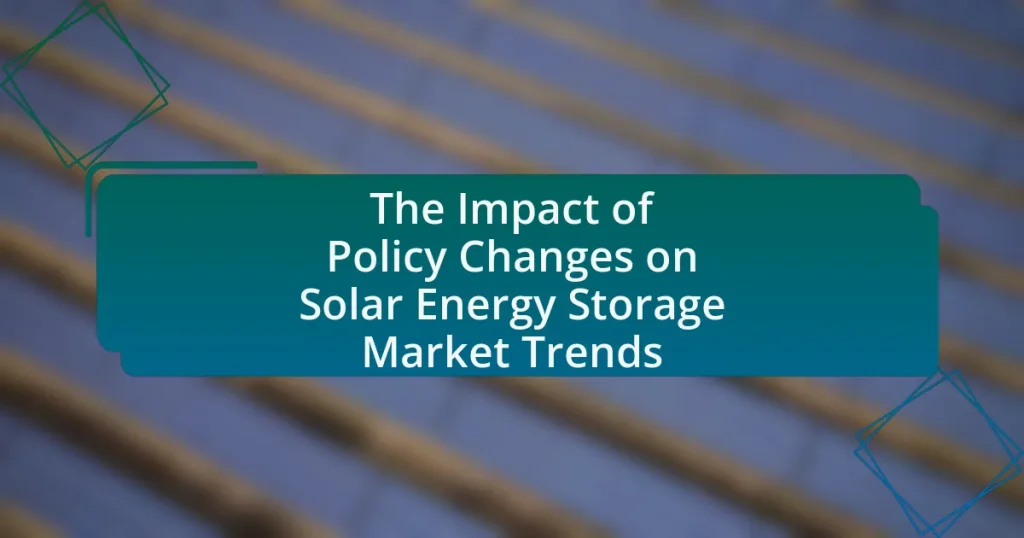The article examines the impact of policy changes on the solar energy storage market, highlighting key factors such as tax incentives, regulatory frameworks, and state mandates that drive market growth. It discusses how government incentives, including the Investment Tax Credit and state-level rebates, significantly lower financial barriers for consumers and businesses, thereby enhancing adoption rates. Additionally, the article explores the variations in incentives across different regions and countries, the influence of safety and performance standards, and the role of interconnection policies in facilitating market expansion. It also addresses the challenges and potential drawbacks arising from policy changes, emphasizing the importance of stakeholder engagement and compliance for navigating the evolving landscape of solar energy storage.
What are the key policy changes affecting the solar energy storage market?


Key policy changes affecting the solar energy storage market include the introduction of tax incentives, regulatory frameworks supporting energy storage deployment, and state-level mandates for renewable energy integration. For instance, the Investment Tax Credit (ITC) allows for a significant tax reduction for solar energy systems, which now includes energy storage systems, thereby encouraging investment. Additionally, policies such as California’s Self-Generation Incentive Program (SGIP) provide financial incentives for residential and commercial energy storage systems, promoting wider adoption. These changes are supported by data indicating that states with strong policy frameworks see higher rates of energy storage installations, reflecting the direct impact of policy on market growth.
How do government incentives influence solar energy storage adoption?
Government incentives significantly enhance solar energy storage adoption by reducing financial barriers for consumers and businesses. These incentives, such as tax credits, rebates, and grants, lower the upfront costs associated with purchasing and installing solar energy storage systems. For instance, the Federal Investment Tax Credit (ITC) allows homeowners to deduct a percentage of the cost of solar systems from their federal taxes, which has been shown to increase installation rates. According to the Solar Energy Industries Association, the ITC contributed to a 167% increase in solar capacity from 2016 to 2020. Additionally, state-level incentives can further stimulate local markets, leading to increased competition and innovation in solar storage technologies.
What types of incentives are most effective in promoting solar energy storage?
Financial incentives, such as tax credits, rebates, and grants, are the most effective in promoting solar energy storage. These incentives lower the upfront costs associated with purchasing and installing solar energy storage systems, making them more accessible to consumers. For instance, the Federal Investment Tax Credit (ITC) allows homeowners to deduct a significant percentage of the cost of solar systems from their federal taxes, which has been shown to increase adoption rates. Additionally, state-level rebates can further reduce costs; for example, California’s Self-Generation Incentive Program has successfully incentivized thousands of installations. Studies indicate that financial incentives can lead to a substantial increase in solar energy storage adoption, with some regions experiencing growth rates exceeding 50% annually when such programs are in place.
How do these incentives vary by region or country?
Incentives for solar energy storage vary significantly by region and country, influenced by local policies, economic conditions, and energy needs. For instance, in the United States, federal tax credits and state-level rebates encourage solar adoption, while countries like Germany offer feed-in tariffs that guarantee fixed payments for solar energy fed into the grid. In contrast, regions such as Sub-Saharan Africa may focus on off-grid solutions and microfinancing to promote solar storage due to limited grid infrastructure. These variations reflect differing governmental priorities, economic capabilities, and energy resource availability, demonstrating how local contexts shape the effectiveness and type of incentives provided.
What regulations impact the solar energy storage market?
Regulations impacting the solar energy storage market include federal policies, state-level incentives, and safety standards. Federal regulations, such as the Investment Tax Credit (ITC), provide financial incentives for solar energy systems, which indirectly benefit storage solutions by making them more economically viable. Additionally, state-level policies, like net metering and renewable portfolio standards, encourage the integration of energy storage with solar installations. Safety standards, such as those set by the National Fire Protection Association (NFPA) and Underwriters Laboratories (UL), ensure that energy storage systems are safe for consumer use, thereby influencing market adoption. These regulations collectively shape the growth and development of the solar energy storage market.
How do safety and performance standards shape the industry?
Safety and performance standards significantly shape the solar energy storage industry by establishing benchmarks that ensure product reliability and consumer protection. These standards, such as those set by Underwriters Laboratories (UL) and the International Electrotechnical Commission (IEC), dictate the design, testing, and operational criteria for energy storage systems. Compliance with these standards not only enhances product safety but also fosters consumer confidence, which is crucial for market growth. For instance, the adoption of UL 9540 for energy storage systems has led to increased market acceptance and investment, as it assures stakeholders of the technology’s safety and performance. Consequently, adherence to these standards drives innovation and competitiveness within the industry, influencing market trends and policy developments.
What role do interconnection policies play in market growth?
Interconnection policies significantly influence market growth by establishing the framework for connecting renewable energy sources, such as solar, to the grid. These policies determine the technical and regulatory requirements for interconnecting solar energy systems, which can either facilitate or hinder the deployment of solar technologies. For instance, streamlined interconnection processes can reduce costs and installation times, thereby encouraging more investments in solar energy. According to the National Renewable Energy Laboratory, states with favorable interconnection policies have seen a 50% increase in solar capacity compared to those with more restrictive regulations. This demonstrates that effective interconnection policies are crucial for enhancing market growth in the solar energy sector.
How do policy changes affect market trends in solar energy storage?


Policy changes significantly influence market trends in solar energy storage by altering incentives, regulations, and funding mechanisms. For instance, the introduction of tax credits and rebates can stimulate demand for solar energy storage systems, as seen in the U.S. where the Investment Tax Credit (ITC) has led to a substantial increase in installations, contributing to a market growth rate of over 20% annually since its implementation. Additionally, stricter regulations on carbon emissions can drive investments in renewable energy solutions, including storage technologies, as companies seek to comply with environmental standards. These policy shifts create a more favorable economic environment for solar energy storage, encouraging innovation and reducing costs through economies of scale.
What are the current market trends in solar energy storage?
The current market trends in solar energy storage indicate a significant increase in demand driven by technological advancements and supportive policy changes. The global energy storage market is projected to grow from approximately 10 gigawatt-hours (GWh) in 2020 to over 200 GWh by 2025, reflecting a compound annual growth rate (CAGR) of around 40%. This growth is largely attributed to declining costs of lithium-ion batteries, which have decreased by about 89% since 2010, making solar energy storage more accessible for residential and commercial applications. Additionally, government incentives and regulations, such as tax credits and renewable energy mandates, are further propelling the adoption of solar energy storage solutions.
How has the market evolved in response to recent policy changes?
The solar energy storage market has evolved significantly in response to recent policy changes, particularly through increased investment and technological advancements. For instance, the introduction of tax incentives and subsidies has led to a surge in demand for solar storage solutions, with the U.S. market experiencing a growth rate of over 30% in 2022 compared to the previous year. Additionally, regulatory frameworks promoting renewable energy integration have encouraged manufacturers to innovate, resulting in improved battery technologies and reduced costs. These developments are supported by data from the Solar Energy Industries Association, which reported that policy shifts have directly correlated with a rise in installations and market participation.
What are the projected trends for the next five years?
The projected trends for the next five years in the solar energy storage market indicate significant growth driven by policy changes. Specifically, governments worldwide are increasingly implementing supportive regulations and incentives aimed at enhancing renewable energy adoption, which is expected to boost the demand for solar energy storage solutions. According to a report by BloombergNEF, the global energy storage market is projected to grow from 10 gigawatt-hours (GWh) in 2020 to over 300 GWh by 2025, reflecting a compound annual growth rate of approximately 40%. This growth is largely attributed to advancements in battery technology, decreasing costs, and the urgency to meet climate goals, further solidifying the role of energy storage in facilitating the transition to a sustainable energy future.
How do policy changes impact consumer behavior regarding solar energy storage?
Policy changes significantly influence consumer behavior regarding solar energy storage by altering financial incentives and regulatory frameworks. For instance, the introduction of tax credits or rebates can increase consumer adoption rates, as seen in the U.S. where the federal solar tax credit has driven a surge in residential solar installations. According to the Solar Energy Industries Association, the U.S. solar market grew by 167% from 2010 to 2020, largely due to favorable policies. Additionally, stricter regulations on energy efficiency can prompt consumers to invest in solar energy storage systems to comply with new standards, further driving market growth.
What factors influence consumer decisions in adopting solar energy storage systems?
Consumer decisions in adopting solar energy storage systems are influenced by several key factors, including cost, government incentives, environmental concerns, and technological advancements. Cost plays a significant role, as consumers often evaluate the initial investment against long-term savings on energy bills. Government incentives, such as tax credits and rebates, can lower the financial barrier, making solar energy storage more attractive. Environmental concerns drive consumers who prioritize sustainability and reducing their carbon footprint. Technological advancements, including improved battery efficiency and lifespan, enhance the appeal of solar energy storage systems by offering better performance and reliability. These factors collectively shape consumer perceptions and decisions in the solar energy storage market.
How do policy changes affect the cost of solar energy storage for consumers?
Policy changes significantly influence the cost of solar energy storage for consumers by altering incentives, subsidies, and regulations. For instance, the introduction of tax credits or rebates can lower the upfront costs of solar storage systems, making them more accessible to consumers. According to the Solar Energy Industries Association, the federal Investment Tax Credit (ITC) has historically boosted solar adoption by providing a 26% tax credit for solar installations, which directly impacts consumer costs. Conversely, the removal of such incentives can lead to increased prices, as seen in states that have reduced or eliminated solar subsidies, resulting in a decline in market demand and higher costs for consumers.
What challenges arise from policy changes in the solar energy storage market?


Policy changes in the solar energy storage market can lead to several challenges, including regulatory uncertainty, financial instability, and market disruption. Regulatory uncertainty arises when new policies create confusion or inconsistency in the rules governing solar energy storage, making it difficult for companies to plan investments or operations. Financial instability can occur if changes in incentives or subsidies reduce the profitability of solar energy storage projects, leading to decreased investment and innovation. Market disruption may happen when sudden policy shifts favor certain technologies or business models over others, potentially sidelining established players and creating barriers for new entrants. These challenges can hinder the growth and adoption of solar energy storage solutions, ultimately affecting the transition to renewable energy sources.
What are the potential drawbacks of recent policy changes?
The potential drawbacks of recent policy changes in the solar energy storage market include increased costs for consumers and potential market instability. These policy changes may lead to higher installation and operational expenses due to new regulations or reduced incentives, which can deter investment and adoption. For instance, a study by the National Renewable Energy Laboratory indicated that changes in federal tax credits could result in a 20% increase in upfront costs for solar installations. Additionally, the uncertainty surrounding policy shifts can create volatility in the market, making it difficult for companies to plan long-term investments, as evidenced by fluctuations in stock prices of solar energy firms following policy announcements.
How can policy changes lead to market instability?
Policy changes can lead to market instability by altering the regulatory environment, which affects investor confidence and market dynamics. For instance, sudden changes in subsidies or tariffs can disrupt established business models, leading to uncertainty among stakeholders. A notable example is the U.S. solar market, where the imposition of tariffs on imported solar panels in 2018 resulted in a 30% increase in costs, causing project delays and reduced installations. This illustrates how policy shifts can create volatility, impacting supply chains and investment flows in the solar energy storage sector.
What unintended consequences might arise from new regulations?
New regulations in the solar energy storage market may lead to unintended consequences such as increased costs for consumers and reduced innovation. For instance, stringent compliance requirements can elevate operational expenses for manufacturers, which may be passed on to consumers through higher prices. Additionally, regulations that favor established technologies over emerging solutions can stifle innovation, limiting the development of more efficient or cost-effective energy storage options. Historical examples, such as the impact of the Feed-in Tariff in Germany, demonstrate how well-intentioned policies can inadvertently create market distortions, leading to higher electricity prices and reduced competition.
How can stakeholders navigate the changing policy landscape?
Stakeholders can navigate the changing policy landscape by actively engaging in policy advocacy and staying informed about regulatory developments. This involves monitoring legislative changes, participating in industry associations, and collaborating with policymakers to influence favorable outcomes. For instance, the Solar Energy Industries Association (SEIA) regularly updates stakeholders on policy shifts and provides resources for effective advocacy, demonstrating the importance of collective action in shaping policy. Additionally, stakeholders can leverage data analytics to assess the impact of policy changes on market trends, enabling them to make informed decisions and adapt their strategies accordingly.
What strategies can businesses employ to adapt to policy changes?
Businesses can employ several strategies to adapt to policy changes, including proactive compliance, stakeholder engagement, and innovation in product offerings. Proactive compliance involves staying informed about regulatory updates and adjusting operations to meet new requirements, which can minimize legal risks and enhance reputation. Stakeholder engagement, such as collaborating with policymakers and industry groups, allows businesses to influence future regulations and align their strategies with emerging trends. Additionally, innovation in product offerings, particularly in the solar energy storage sector, can help businesses capitalize on new market opportunities created by policy shifts, such as incentives for renewable energy adoption. For instance, the implementation of tax credits for solar energy systems has led to increased demand for energy storage solutions, prompting companies to develop advanced technologies that meet these new market needs.
How can consumers stay informed about policy impacts on solar energy storage?
Consumers can stay informed about policy impacts on solar energy storage by regularly following updates from government agencies, industry associations, and reputable news sources. Government websites, such as the U.S. Department of Energy, provide official information on policy changes and their implications for solar energy. Industry associations like the Solar Energy Industries Association publish reports and analyses that highlight how policies affect market trends. Additionally, subscribing to newsletters from these organizations and engaging with community forums can offer insights and discussions on recent developments. Research indicates that informed consumers are better equipped to make decisions regarding solar energy investments, as policies can significantly influence costs and incentives.
What best practices should be followed in light of policy changes?
In light of policy changes, best practices include conducting thorough impact assessments, engaging stakeholders, and ensuring compliance with new regulations. Conducting impact assessments allows organizations to understand how policy changes affect operations and market dynamics, particularly in the solar energy storage sector. Engaging stakeholders, such as customers, suppliers, and regulatory bodies, fosters collaboration and helps identify potential challenges and opportunities arising from policy shifts. Ensuring compliance with new regulations is crucial to avoid legal repercussions and maintain market credibility, as non-compliance can lead to significant financial penalties and reputational damage. These practices are essential for adapting to the evolving landscape of the solar energy storage market.


